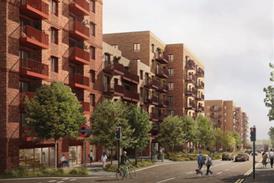Miranda MacLaren argues that financial reform, fairer procurement and design for local delivery are essential to revive small builders and rebuild housebuilding capacity

Recently, discussing with a developer friend the fact that none of their small infill planning-consented schemes are actually viable now and are unbuildable because of it, I felt the familiar frustration.
Behind Steve Reed’s plan to reduce London’s affordable housing quota from 35% to 20% lies a deeper truth: we’ve systematically excluded the very people best placed to solve our housing crisis. Small and medium-sized developers, working with trusted local contractors, once delivered nearly 40% of Britain’s homes. Today, they build just 10%.
The maths is brutal for small development teams. A major developer building over 500 units spreads fixed costs across the entire scheme and negotiates better supplier rates. An SME developer working with local contractors on 10 units faces proportionally higher costs per unit whilst operating with limited working capital.
When CIL charges, Section 106 contributions and compliance costs apply uniformly regardless of scale, small developer-contractor partnerships are structurally disadvantaged. They face the same infrastructure levies and tax burdens as major developers but lack the economies of scale and financial reserves to absorb them.
The procurement barrier
The problem extends beyond private development. Local authority-led infill housing, precisely the kind of small-scale development SME teams excel at, is often locked behind procurement rules designed for large contracts.
Complex tendering processes and extensive pre-qualification requirements systematically exclude the local builders best placed to deliver these projects. Councils struggle to deliver small housing schemes, whilst local contractors with intimate knowledge of the area, existing relationships with suppliers and available capacity are prevented from bidding.
Skills and local knowledge that could solve housing problems remain unused, leading to skill atrophy in the very communities that need development most.
Breaking back in
To bring SME teams back requires targeted interventions across both private and public development:
- Proportionate infrastructure contributions: Better access to existing CIL exemptions for SME-led affordable housing, extended instalment payment arrangements and wider promotion of the 100-square-metre threshold for small infill projects.
- Tax relief: Targeted VAT exemptions for SME housing schemes, particularly conversions and brownfield developments where small developer-contractor teams have natural advantages.
- Reformed procurement: Simplified procurement processes for local authority housing schemes under 50 units, with local supplier requirements and streamlined pre-qualification that favours community knowledge over corporate credentials.
- Access to capital: Specialist lending facilities for SME developers, addressing working capital constraints that make small partnerships vulnerable to delays and cost overruns.
The maintenance advantage
There’s a crucial long-term benefit when local SME teams build housing: they remain available to maintain it. Large-scale developments built by tier-one contractors are typically handed over to management companies who lack access to the original builders’ skills and knowledge. Equipment remains unmaintained, systems fail and homes deteriorate.
Local developer-contractor partnerships understand what they’ve built and remain in the community to service it. This creates sustainable local economies where housing isn’t just delivered but properly maintained, preserving value and creating ongoing employment for skilled trades.
Planning as accelerator
Once viability and procurement are addressed, fast-track planning becomes the accelerator. Pre-approved design frameworks for conversions, infill schemes and brownfield intensification could provide certainty for SME teams whilst maintaining quality standards.
But planning reform only works when underlying development is economically feasible and local teams can actually access the work. Rapid approvals won’t bring SME partnerships back if the cost structure remains prohibitive or procurement rules exclude them from public projects.
Design for local delivery
We need an agreed low-tech solutions strategy where designs are purposefully made fit for small builders to procure, build and maintain. Too often, architects and designers create schemes that look impressive on paper but require specialist contractors, imported materials and complex building systems that only large developers can deliver.
When we price out the builders who know their communities, understand local materials and remain available to maintain what they’ve built, we undermine the very foundation of affordable housing
Designers must become cognisant of the proportional attitude to the scale of development. A 10-unit scheme shouldn’t require the same complex mechanical systems, imported materials or specialist contractors as a 200-unit development. Simple structural solutions, standard materials available from local suppliers and straightforward building services allow SME teams to compete on their natural advantages: local knowledge, personal relationships and responsive service.
This isn’t about compromising quality, it’s about designing for buildability. Traditional construction methods, proven material combinations and systems that local trades understand create opportunities for SME teams whilst delivering homes that communities can actually afford. When designs match the scale and capacity of local supply chains, the economics of small development start to work again.
The real opportunity
Reed’s quota reduction could unlock smaller sites and make sub-100-unit projects viable again for SME developer-contractor teams. But without addressing fundamental viability, procurement and design barriers, we risk solving the wrong problem.
The solution starts with creating market conditions where local partnerships can compete: proportionate infrastructure contributions, targeted tax relief, reformed procurement for public housing, improved capital access, designs that match local capacity, and recognition that local teams deliver both immediate housing and long-term maintenance capability.
This isn’t just about buildings or statistics. It’s about recognising that sustainable housing delivery requires sustainable local economies. When we price out the builders who know their communities, understand local materials and remain available to maintain what they’ve built, we undermine the very foundation of affordable housing.
These SME teams scattered across our towns and cities aren’t just business casualties of regulatory creep. They’re the potential backbone of housing delivery, waiting to be given viable pathways back into a market that has forgotten their value.
>> Also read: Vacant to valuable: unlocking stranded assets for much-needed homes
>> Also read: Why building a culture of viability is key to safeguarding quality in major housing programmes
Postscript
Miranda MacLaren is a director at Orms.
















3 Readers' comments